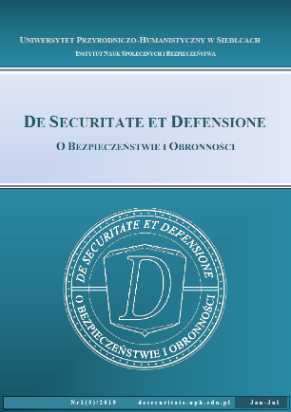Frontex w systemie zarządzania bezpieczeństwem granic Unii Europejskiej
Frontex in the Border Security Management System of the European Union
Author(s): Zbigniew Ciekanowski, Julia Nowicka, Sławomir ŻurawskiSubject(s): Politics / Political Sciences, Social Sciences, Security and defense, EU-Approach / EU-Accession / EU-Development
Published by: Uniwersytet w Siedlcach
Keywords: agency;security;border;migration;zone
Summary/Abstract: The main purpose of this article is to describe the EU Agency, which is the European Borderand Coast Guard Agency (Frontex), as well as to present the role it plays in the EU’s external border managementsystem. In the first part of the article, the authors present basic information on the asylum and migrationpolicy of the EU. Then they describe the EU’s external border management system and indicate therole of Frontex in this system, characterizing the Agency's instruments, i.e. EUROSUR, ETIAS, and FADO. The main part of the article focuses on the structure and tasks of Frontex. In summary, they draw attentionto globalization, cultural, economic, and military changes, which bring with them serious threats and disturbthe stable existence of citizens of the European Union. The article also shows that the Frontex Agency significantlyincreases the level of security of the European Union. The main research problem was expressedby the following question: What impact does the activity of the European Border and Coast Guard Agencyhave on the security of the European Union's borders? The following hypothesis was adopted: the Borderand Coast Guard Agency, through its activities, increases the level of security of the borders of the EuropeanUnion. Complementary, to solve the main research problem, the following specific problems are: What isthe EU’s asylum and migration policy? What tasks does Frontex perform to enhance border security? andwhat tools does it use to enhance the border management system? Verification of the above hypothesis andobtaining of answers to the above questions required the use of qualitative methods, including critical analysisof legal acts, policy documents, and selected items of literature on the subject. The authors’ previousknowledge of the issue was also taken into account.
Journal: De Securitate et Defensione. O Bezpieczeństwie i Obronności
- Issue Year: 8/2022
- Issue No: 2
- Page Range: 176-186
- Page Count: 11
- Language: Polish

